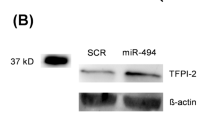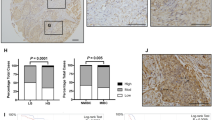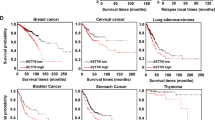Abstract
Tristetraprolin (TTP or ZFP36) is a tandem CCCH zinc-finger RNA-binding protein that regulates the stability of certain AU-rich element (ARE) mRNAs. Recent work suggests that TTP is deficient in cancer cells when compared with normal cell types. In this study we found that TTP expression was lower in invasive breast cancer cells (MDAMB231) compared with normal breast cell lines MCF12A and MCF-10. TTP targets were probed using a novel approach by expressing the C124R zinc-finger TTP mutant that functions as dominant negative and increases target mRNA expression. In contrast to wild-type TTP, C124R TTP was able to increase certain ARE-mRNA expressions in serum-stimulated breast cancer cells. Using an ARE-gene microarray, novel targets of TTP regulation were identified, namely, urokinase plasminogen activator (uPA), uPA receptor and matrix metalloproteinase-1, all known to have prominent roles in breast cancer invasion and metastasis. Expression of these targets was upregulated in tumorigenic types, particularly in highly invasive MDAMB231. The mRNA half-lives of these TTP-regulated genes were increased in TTP-knockout embryonic mouse fibroblasts, as assessed using real-time polymerase chain reaction, whereas forced restoration of TTP by transfection led to a reduction in their mRNA levels. RNA immunoprecipitation confirmed an association of TTP, but not C124R, with these target transcripts. Moreover, TTP reduced, whereas the mutant C124R TTP increased, the activity of reporter constructs fused to target ARE. As a result of TTP regulation, invasiveness of MDAMB231 cells was reduced. The data suggest that TTP, in a 3′ untranslated region—and ARE-dependent manner, regulates an important subset of cancer-related genes that are involved in cellular growth, invasion and metastasis.
This is a preview of subscription content, access via your institution
Access options
Subscribe to this journal
Receive 50 print issues and online access
$259.00 per year
only $5.18 per issue
Buy this article
- Purchase on Springer Link
- Instant access to full article PDF
Prices may be subject to local taxes which are calculated during checkout







Similar content being viewed by others
References
Al-Ahmadi W, Al-Ghamdi M, Al-Haj L, Al-Saif M, Khabar KS . (2009a). Alternative polyadenylation variants of the RNA binding protein, HuR: abundance, role of AU-rich elements and auto-regulation. Nucl Acids Res 37: 3612–3624.
Al-Ahmadi W, Al-Haj L, Al-Mohanna FA, Silverman RH, Khabar KS . (2009b). RNase L downmodulation of the RNA-binding protein, HuR, and cellular growth. Oncogene 28: 1782–1791.
Asyali MH, Shoukri MM, Demirkaya O, Khabar KSA . (2004). Assessment of reliability of microarray data and estimation of signal thresholds using mixture modeling. Nucl Acids Res 32: 2323–2335.
Bacac M, Stamenkovic I . (2008). Metastatic cancer cell. Annu Rev Pathol: Mech Dis 3: 221–247.
Blackshear PJ . (2002). Tristetraprolin and other CCCH tandem zinc-finger proteins in the regulation of mRNA turnover. Biochem Soc Trans 30: 945–952.
Brennan CM, Kuwano Y, Alkharouf N, Blackshear PJ, Gorospe M, Wilson GM . (2009). The mRNA-destabilizing protein tristetraprolin is suppressed in many cancers, altering tumorigenic phenotypes and patient prognosis. Cancer Res 69: 5168–5176.
Carballo E, Lai WS, Blackshear PJ . (1998). Feedback inhibition of macrophage tumor necrosis factor-{alpha} production by tristetraprolin. Science 281: 1001–1005.
Carballo E, Lai WS, Blackshear PJ . (2000). Evidence that tristetraprolin is a physiological regulator of granulocyte-macrophage colony stimulating factor messenger RNA deadenylation and stability. Blood 95: 1891–1899.
Christensen L, Wiborg Simonsen AC, Heeqaard CW, Moestrup SK, Andersen JA, Andreasen P . (1996). Immunohistochemical localization of urokinase-type plasminogen activator, type-1 plasminogen-activator inhibitor, urokinase receptor and alpha(2)-macroglobulin receptor in human breast carcinomas. Int J Cancer 66: 441–452.
Dass K, Ahmad A, Azmi AS, Sarkar SH, Sarkar FH . (2008). Evolving role of uPA/uPAR system in human cancers. Cancer Treat Rev 34: 122–136.
de Silanes IL, Fan J, Yang X, Zonderman AB, Potapova O, Pizer ES et al. (2003). Role of the RNA-binding protein HuR in colon carcinogenesis. Oncogene 22: 7146–7154.
Denkert C, Weichert W, Pest S, Koch I, Licht D, Kobel M et al. (2004). Overexpression of the embryonic-lethal abnormal vision-like protein HuR in ovarian carcinoma is a prognostic factor and is associated with increased cyclooxygenase 2 expression. Cancer Res 64: 189–195.
DuBois RN, McLane MW, Ryder K, Lau LF, Nathans D . (1990). A growth factor-inducible nuclear protein with a novel cysteine/histidine repetitive sequence. J Biol Chem 265: 19185–19191.
Essafi-Benkhadir K, Onesto C, Stebe E, Moroni C, Pages G . (2007). Tristetraprolin inhibits Ras-dependent tumor vascularization by inducing vascular endothelial growth factor mRNA degradation. Mol Biol Cell 18: 4648–4658.
Fini ME, Plucinska IM, Mayer AS, Gross RH, Brinckerhoff CE . (1987). A gene for rabbit synovial cell collagenase: member of a family of metalloproteinases that degrade the connective tissue matrix. Biochemistry 26: 6157–6165.
Fisher JL, Field CL, Zhou H, Harris TL, Henderson MA, Choong PF . (2000). Urokinase plasminogen activator system gene expression is increased in human breast carcinoma and its bone metastases – a comparison of normal breast tissue, non-invasive and invasive carcinoma and osseous metastases. Breast Cancer Res Treat 61: 1–12.
Gebeshuber CA, Zatloukal K, Martinez J . (2009). miR-29a suppresses tristetraprolin, which is a regulator of epithelial polarity and metastasis. EMBO J Rep 10: 400–405.
Heinonen M, Fagerholm R, Aaltonen K, Kilpivaara O, Aittomaki K, Blomqvist C et al. (2007). Prognostic role of HuR in hereditary breast cancer. Clin Cancer Res 13: 6959–6963.
Iwata H, Kobayashi S, Iwase H, Masaoka A, Fujimoto N, Okada Y . (1996). Production of matrix metalloproteinases and tissue inhibitors of metalloproteinases in human breast carcinomas. Jpn J Cancer Res 87: 602–611.
Khabar KS, Al-Haj L, Al-Zoghaibi F, Marie M, Dhalla M, Polyak SJ et al. (2004). Expressed gene clusters associated with cellular sensitivity and resistance towards anti-viral and anti-proliferative actions of interferon. J Mol Biol 342: 833–846.
Kleiner DE, Stetler-Stevenenson W . (1999). Matrix metalloproteinases and metastasis. Cancer Chemother Pharmacol 43: S42–S51.
Lai WS, Carballo E, Strum JR, Kennington EA, Phillips RS, Blackshear PJ . (1999). Evidence that tristetraprolin binds to AU-rich elements and promotes the deadenylation and destabilization of tumor necrosis factor alpha mRNA. Mol Cell Biol 19: 4311–4323.
Lai WS, Carballo E, Thorn JM, Kennington EA, Blackshear PJ . (2000). Interactions of CCCH zinc finger proteins with mRNA. Binding of tristetraprolin-related zinc finger proteins to AU-rich elements and destabilization of mRNA. J Biol Chem 275: 17827–17837.
Lai WS, Kennington EA, Blackshear PJ . (2002). Interactions of CCCH zinc finger proteins with mRNA. Non-binding tristetraprolin mutants exert an inhibitory effect on degradation of AU-rich element-containing mRNAs. J Biol Chem 277: 9606–9613.
Lai WS, Parker JS, Grissom SF, Stumpo DJ, Blackshear PJ . (2006). Novel mRNA targets for tristetraprolin (TTP) identified by global analysis of stabilized transcripts in TTP-deficient fibroblasts. Mol Cell Biol 26: 9196–9208.
Lai WS, Stumpo DJ, Blackshear PJ . (1990). Rapid insulin-stimulated accumulation of an mRNA encoding a proline-rich protein. J Biol Chem 265: 16556–16563.
Liotta LA . (1986). Tumor invasion and metastases—role of the extracellular matrix: Rhoads Memorial Award lecture. Cancer Res 46: 1–7.
Liotta LA, Tryggvason K, Garbisa S, Hart I, Foltz CM, Shafie S . (1980). Metastatic potential correlates with enzymatic degradation of basement membrane collagen. Nature 284: 67–68.
McPherson K, Steel CM, Dixon JM . (2000). ABC of breast diseases: breast cancer—epidemiology, risk factors, and genetics. Br Med J 321: 624–628.
Mrena J, Wiksten J-P, Thiel A, Kokkola A, Pohjola L, Lundin J et al. (2005). Cyclooxygenase-2 is an independent prognostic factor in gastric cancer and its expression is regulated by the messenger RNA stability factor HuR. Clin Cancer Res 11: 7362–7368.
Nanbu R, Menoud PA, Nagamine Y . (1994). Multiple instability-regulating sites in the 3′ untranslated region of the urokinase-type plasminogen activator mRNA. Mol Cell Biol 14: 4920–4928.
Nanbu R, Montero L, D'Orazio D, Nagamine Y . (1997). Enhanced stability of urokinase-type plasminogen activator mRNA in metastatic breast cancer MDA-MB-231 cells and LLC-PK, cells down-regulated for protein kinase C correlation with cytoplasmic heterogeneous nuclear ribonucleoprotein C. Eur J Biochem 247: 169–174.
Quax PHA, van Leeuwen RTJ, Verspaget HW, Verheijen JH . (1990). Protein and messenger RNA levels of plasminogen activators and inhibitors analyzed in 22 human tumor cell lines. Cancer Res 50: 1488–1494.
Roldan AL, Cubellis MY, Masucci MT, Behrendt NL, Lund LR, Dano K et al. (1990). Cloning and expression of the receptor for human urokinase plasminogen activator, a central molecule in cell surface plasmin dependent proteolysis. EMBO J 9: 467–474.
Sawaoka H, Dixon DA, Oates JA, Boutaud O . (2003). Tristetraprolin binds to the 3′-untranslated region of cyclooxygenase-2 mRNA. A polyadenylation variant in a cancer cell line lacks the binding site. J Biol Chem 278: 13928–13935.
Shetty S, Kumar A, Idell S . (1997). Posttranscriptional regulation of urokinase receptor mRNA: identification of a novel urokinase receptor mRNA binding protein in human mesothelioma cells. Mol Cell Biol 17: 1075–1083.
Soslow RA, Dannenberg AJ, Rush D, Woerner BM, Khan KN, Masferrer J et al. (2000). COX-2 is expressed in human pulmonary, colonic, and mammary tumors. Cancer 89: 2637–2645.
Stoecklin G, Tenenbaum SA, Mayo T, Chittur SV, George AD, Baroni TE et al. (2008). Genome-wide analysis identifies interleukin-10 mRNA as target of tristetraprolin. J Biol Chem 283: 11689–11699.
Suswam E, Li Y, Zhang X, Gillespie GY, Li X, Shacka JJ et al. (2008). Tristetraprolin down-regulates interleukin-8 and vascular endothelial growth factor in malignant glioma cells. Cancer Res 68: 674–682.
Tran H, Maurer F, Nagamine Y . (2003). Stabilization of urokinase and urokinase receptor mRNAs by HuR is linked to its cytoplasmic accumulation induced by activated mitogen-activated protein kinase-activated protein kinase 2. Mol Cell Biol 23: 7177–7188.
Vincenti MP, Brinckerhoff CE . (2002). Transcriptional regulation of collagenase (MMP-1, MMP-13) genes in arthritis: integration of complex signaling pathways for the recruitment of gene-specific transcription factors. Arthritis Res 4: 157–164.
Vincenti MP, Coon CI, Lee O, Brinckerhoff CE . (1994). Regulation of collagenase gene expression by IL-1 requires transcriptional and post-transcriptional mechanisms. Nucl Acids Res 22: 4818–4827.
Vlasova IA, Tahoe NM, Fan D, Larsson O, Rattenbacher B, Sternjohn JR et al. (2008). Conserved GU-rich elements mediate mRNA decay by binding to CUG-binding protein 1. Mol Cell 29: 263–270.
Wang GJ, Collinge M, Blasi F, Pardi R, Bender JR . (1998). Posttranscriptional regulation of urokinase plasminogen activator receptor messenger RNA levels by leukocyte integrin engagement. Proc Natl Acad Sci USA 95: 6296–6301.
Young LE, Sanduja S, Bemis-Standoli K, Pena EA, Price RL, Dixon DA . (2009). The mRNA binding proteins HuR and tristetraprolin regulate cyclooxygenase 2 expression during colon carcinogenesis. Gastroenterology 136: 1669–1679.
Acknowledgements
This study is a part of the Newcastle University doctoral thesis requirements of NA-S. NA-S was supported by a PhD scholarship from King Khalid Foundation, Riyadh. We acknowledge Dr Wi S Lai for TTP plasmids and for the knockout MEF line. We also acknowledge Mr Maher Al-Saif for his technical assistance.
Author information
Authors and Affiliations
Corresponding author
Ethics declarations
Competing interests
The authors declare no conflict of interest.
Additional information
Supplementary Information accompanies the paper on the Oncogene website
Supplementary information
Rights and permissions
About this article
Cite this article
Al-Souhibani, N., Al-Ahmadi, W., Hesketh, J. et al. The RNA-binding zinc-finger protein tristetraprolin regulates AU-rich mRNAs involved in breast cancer-related processes. Oncogene 29, 4205–4215 (2010). https://doi.org/10.1038/onc.2010.168
Received:
Revised:
Accepted:
Published:
Issue Date:
DOI: https://doi.org/10.1038/onc.2010.168
Keywords
This article is cited by
-
Post-transcriptional screen of cancer amplified genes identifies ERBB2/Her2 signaling as AU-rich mRNA stability-promoting pathway
Oncogenesis (2021)
-
MAPKAPK2: the master regulator of RNA-binding proteins modulates transcript stability and tumor progression
Journal of Experimental & Clinical Cancer Research (2019)
-
Identification of potential biomarkers related to glioma survival by gene expression profile analysis
BMC Medical Genomics (2019)
-
Targeting AU-rich element-mediated mRNA decay with a truncated active form of the zinc-finger protein TIS11b/BRF1 impairs major hallmarks of mammary tumorigenesis
Oncogene (2019)
-
Destabilization of NOXA mRNA as a common resistance mechanism to targeted therapies
Nature Communications (2019)



